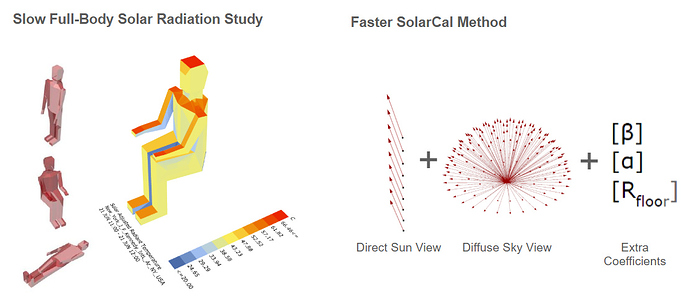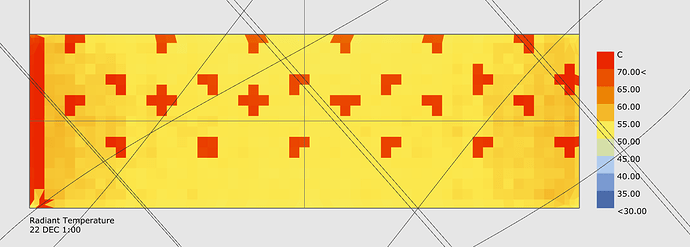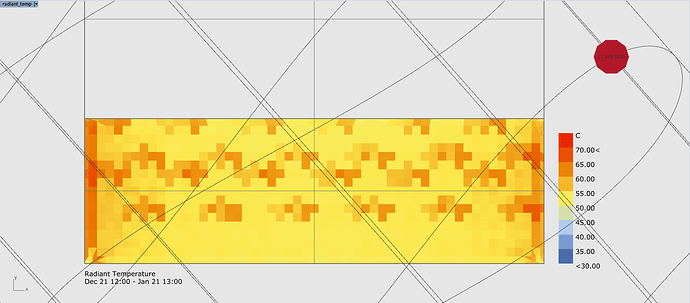Hi everyone,
I am now doing a study of the indoor radiation temperature. I wonder that whether the Adaptive Comfort Analysis Recipe component and the Microclimate Map component used the SolarCal module when calculating the radiation temperature. I noticed that Fbes(Fraction of body exposed to sun) and Fsvv(Sky vault view fraction) were needed when calculated the delta MRT on the CBE Thermal Comfort Tool for ASHRAE-55 website.Does Honeybee consider these two parameters when calculating radiation temperature, and how do these two parameters are reflected in the calculation?
@mercury1123 ,
Excellent question. The Honeybee microclimate maps and Ladybug Solar Temperature Adjustor are using the SolarCal model.
The Fsvv is computed by shooting out a hemisphere of rays from the point of interest (where the occupant is located) and seeing how many rays get through geometry to see the sky. This is the case for both the microclimate maps and the solar temperature adjustor.
For the Fbes, the sun vector for the given hour is shot through the point(s) of interest to see if the occupant’s body sees the sun and experiences the effect of direct sun. I say point(s) because the number of points used varies depending upon whether you are using the microclimate maps or the solar temperature adjustor. Since the microclimate maps are concerned about comfort at series of individual points in space, only a single point is used and so the Fbes can only be a 0 or a 1. For the solar temperature adjustor, at least 3 points are used (feet, mid-section and head) and as much as 9 may be used. This results in something that can be a true fraction of the body rather than a 0 or a 1.
Altogether, I typically explain the solarcal model to people using the following graphic:
Whereas, historically, we had to do an entire solar radiation study of human geometry to estimate the MRT delta from the sun, the SolarCal model simplifies this by only tracing a few vectors from points of interest and using coefficients to account for how the sun falls onto the human geometry.
I just wanted to add that I have uploaded a hydra example file that give some more insight into how the microclimate maps work:
http://hydrashare.github.io/hydra/viewer?owner=chriswmackey&fork=hydra_2&id=Deconstructed_Microclimate_Map
It is specifically helpful for understanding how the SolarCal model is integrated and this script allows a finer level of control over the SolarCal inputs than the basic microclimate maps.
Hi chris, I am doing a shading study under skylights for a big roof.
I set up comfort autonomy definition from hydrashare, and want to find out comfort levels.
-
I am looking at radiant temperature. what is the default material (default floor) and how to change?
-
for the radiant temperature what is too much? any information or standard about this for people waiting in line? for what I am studying, the result air temperature is 28 but all tiles are returning overheated. the purpose of this study is to see if current baseline design of skylight and louvers are adaquate for thermal comfort.
-
for louvers, i understand that you can either a choose custom geometry but cannot change reflectance, or use windowshade generator but can’t do custom gemetry. has there been a work around for this? and if I had louver material to aluminium, could this effect thermal comfort significantly?
-
I am thinking i need to plugin in shade geometr for both exportToOpenStudio and IndoorViewFactor (talking about louvers under skylights). its taking very very long to add louvers to the definition. what the fastest and roughly accurate way to model and input louvers in this case?
-
I read here that one can use lightshelf to change material for shades.(here)
if i use SHDdesign for louvers to both exportToOpenStudio and IndoorViewFactor, will the reflectivity be reflected in the calculation? -
and for the raidant temperature, if I set analysis period for a month, does it take an averange of all hours for each tile? I guess i didn’t understand why the radiant temperature is so high if I did 24 hour cycles. (result ranging from 45-70 degrees celcius). There must be an error because i am getting really high temperatures at night…?
Thank you !!
about 6, I solved the error of night time high temperatures it by adding hvac component from the deconstructed microclimated map definition and disconnected the totalThermalLoad to avoid errors. I still think the radiant temperatures during the days are very high. I am not sure how much of the high radiant temperatures translates to discomfort? and is it possible model linear diffusers ?


